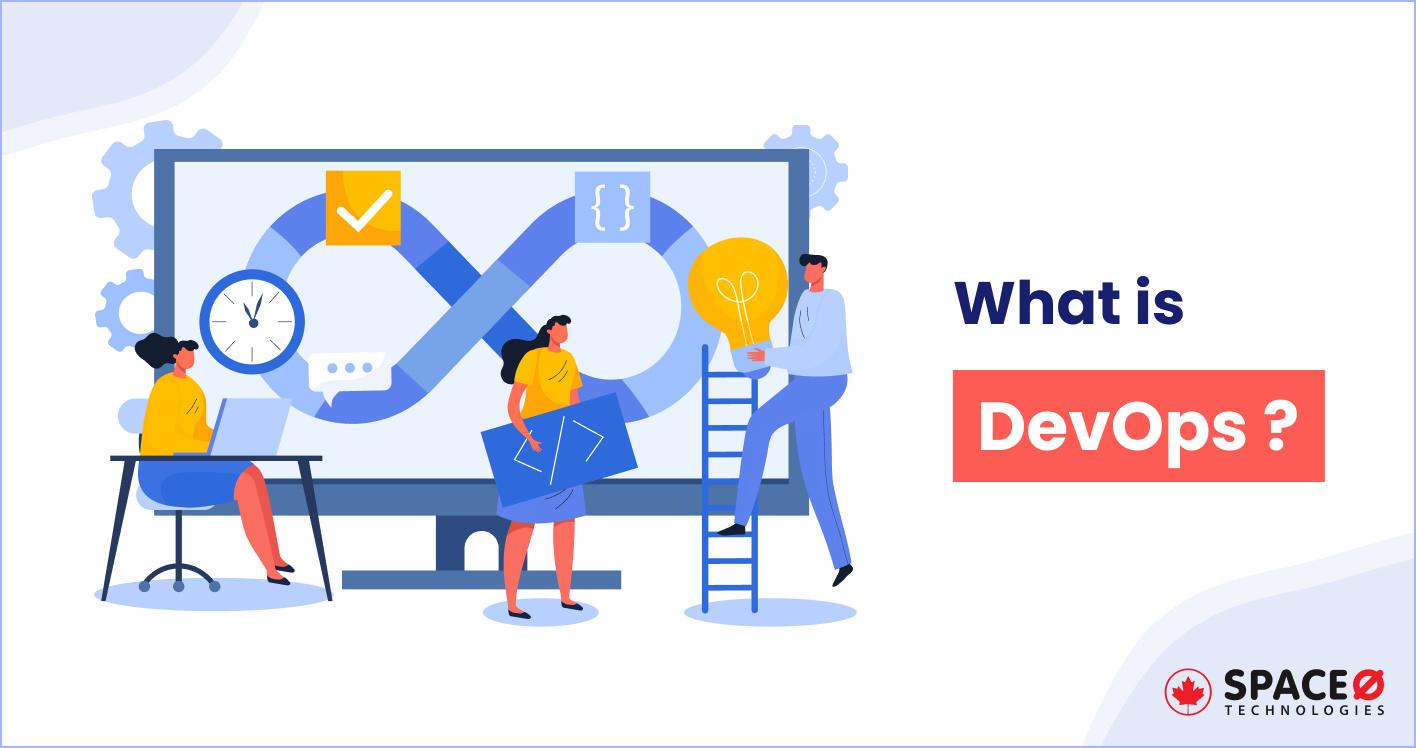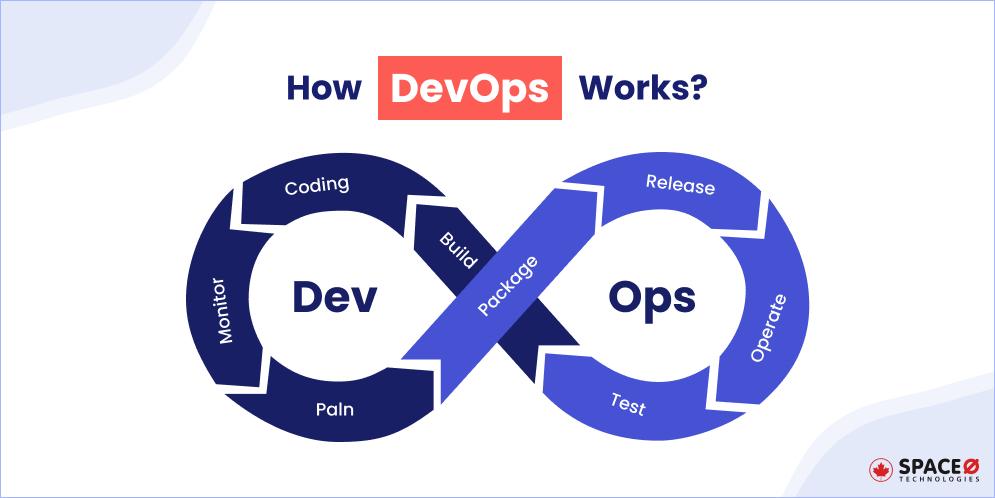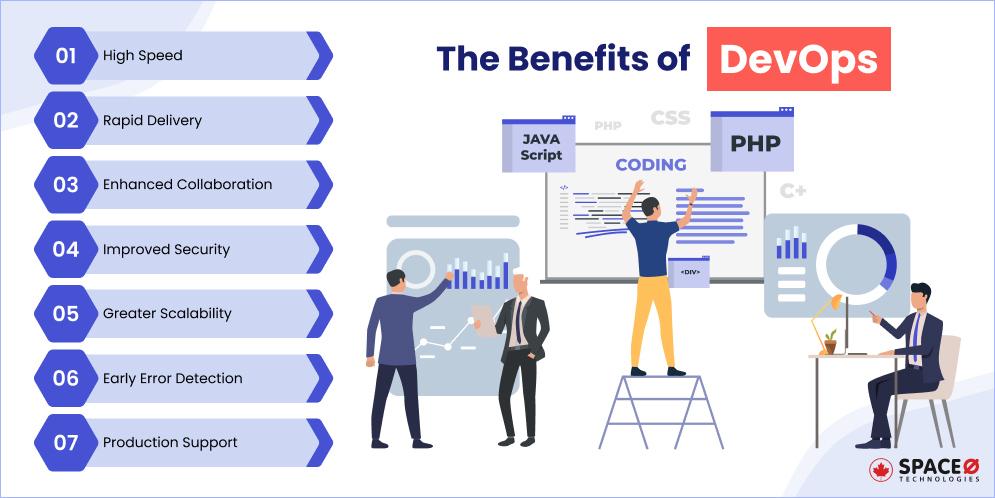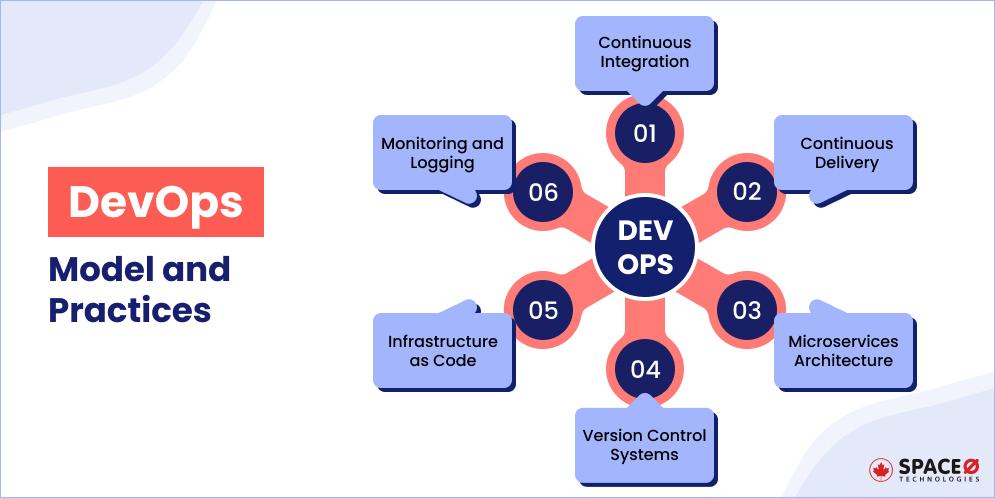
What is DevOps and How Does It Work?
We know DevOps is having a moment since more than 50% of the organizations implemented DevOps in the last 2 years. So now when the future of IT operations sets its eyes on DevOps, many startups and businesses want to know what is DevOps and how it works. Is it a role, an approach, a theory, or a combination of all? Or maybe it means different to different groups of people? We have answered all your questions in this blog post. Continue to read.
Table of Contents
What is DevOps?
DevOps is a methodology for software development that integrates software development (Dev) with operations in information technology (Ops) that engage together in the whole product service lifecycle, from design to different phases of development to testing support.
In simple words, the term DevOps given by Patrick Debois refers to a combination of development and operations. The aim is to bridge the gap between IT operations and development in order to facilitate communication, seamless processes, and to create effective implementation methods.
But it isn’t just a series of acts. It is something of the culture and even an ideology that encourages collaboration between cross-functional teams. One of DevOps’ key advantages is that it does not entail major technological improvements that are more geared towards improving the way a development team operates.
How DevOps Works?
Just like all cultures, DevOps introduces several iterations of the development pattern. Most analysts, however, would accept that the following capabilities are common to nearly all communities.

Step 1. Plan
- Ops organize the tasks and schedule
- The project manager sets up project infrastructure management tools
Step 2. Code
- Devs write codes
- Use source code management tools and review the codes
- System administrators merge codes once reviewed
Step 3. Build
- Build artifact and the source code in the desired format
- Once engineer teams built source codes, use CI/CD tools to verify source codes
Step 4. Test
- Implement testing tools in your workflow to ensure high quality
- Receive feedback on business risks and determine the performance
Step 5. Package
- Implement packaging tools (software repository tools) to inline with business requirements and business goals
- Validate the package and key practices
- Import packaging into a deployment tool
Step 6. Release
- Manage changes
- Approve software releases
- Release automation and apps delivery
Step 7. Operate
- Operation department maintain, monitor, and troubleshoot applications
- Security teams check the security
- Recover and manage data backup and logs
Step 8. Monitor
- Ops monitor service performance
- Monitor logs
- Manage incident and end-user experience
Want to Develop Software by Adopting DevOps Method?
Looking for a reliable software firm? Want to discuss your software requirements? Space-O can help you to convert your vision into a reality.

The Benefits of DevOps
DevOps’ various advantages enlighten by Gene Kim will allow you to gain an edge on other innovations in the IT market. There are some of them:

High Speed
DevOps lets the developers keep an eye on the device during its whole development cycle for any app changes or glitches. This lowers the time for bugs to be tracked, found, and patched, which speeds up your time to market.
The DevOps paradigm also enables you to innovate quickly with consumers, better respond to evolving markets, and become more successful at driving business outcomes.
Rapid Delivery
The core principles of adopting DevOps are continuous integration and continuous delivery, rapid feedback loop and continuous monitoring, which makes the processes of agile software development quicker and more efficient.
Plus, it uses automation to ensure a smooth flow of the SDLC (Software Development Life Cycle) as an evolutionary stretch of the Agile technique. It provides the scope for quick and consistent reviews by fostering a shared DevOps culture such that any bugs are corrected in time.
Enhanced Collaboration
When you implement the cultural paradigm of Dev Ops, you can create more productive teams that emphasize principles like ownership and responsibility. Now as developers and operations departments work well together, share many tasks, and merge their workflows, it decreases errors and saves time as improving collaboration.
Improved Security
The Dev and Ops model uses automatic enforcement rules, fine-grained controls, and configuration management techniques that help to move quickly while retaining leverage and ensuring compliance policies. For example, you can describe and then monitor enforcement at scale, using infrastructure as code and policy as code.
Greater Scalability
DevOps automation and continuity allow you to navigate dynamic (navigation menu) or evolving processes effectively and with decreased risk. Infrastructure as code, for example, lets you handle the production environments, testing, and output in a repeatable and more effective way that improves scalability.
Early Error Detection
The integrated Dev Ops atmosphere encourages an information-sharing community around the departments. As business results, the overall performance of the building tends to be improved by automatic, continuous monitoring, and continuing code testing.
When Dev Ops teams are advised to share their advice with each other, it helps to recognize the faults early and to correct them.
Production Support
In this model, engineers not only work on new updates but within a solution that is already in a development environment and they also concentrate on solving crucial security issues in real-time.
While they are the third and last team to be interested in solving manufacturing challenges, it is a very normal phenomenon and provides them with insights into production concerns that, in the first place, help them design better solutions.
DevOps Principles
While it is a functional approach, in an organization it is also essentially an attitude and cultural transformation. This theory is underscored by main principles as follows.
- Automation: Ops follows the automation principle to automate everything, such as workflows, checking new code, and how to minimize duplication and overwork by provisioning the infrastructure.
- Iteration: To support software updates and sub-releases that accelerate the speed and duration of launches, it writes small pieces of code during a time-box sprint.
- Continuous Improvement: In order to maximize efficiency, cost, and time for implementation, they constantly test, learn from mistakes, and act on feedback.
- Continuous Testing: To enable faster releases and higher quality assurance at the same time, the DevOps environment follows continuous testing.
- Collaboration: To combine efforts and reach success faster, Dev Ops initiate the collaboration between developers and Ops.
Also, you can read our complete guide on SRE vs DevOps. Know how both approaches empower the development processes differently.
DevOps Model and Practices
Dev and Ops include a product delivery cycle consisting of planning, agile development (an umbrella term), testing, rollout, release, and monitoring with active collaboration between a team’s multiple participants. To break down the test process, let’s take a look at the DevOps practices that define its culture.

Continuous Integration
Continuous integration is a development practice (DevOps), in which developers often integrate code modifications into the main branch of code. CI uses automatic testing, which runs any time fresh code is committed, ensuring that the code is still secure in the main branch.
Continuous Delivery
Continuous delivery is a practice given by Jez Humble where code updates are automatically constructed, reviewed, and scheduled for output release to customers. After continuous integration, it extends by deploying all code improvements to a testing environment and a production environment after the development process.
Microservices Architecture
Another DevOps practice is a microservices architecture which is a design method to build a single program as a series of small services. Each service functions in its own process and communicates with other services using a lightweight framework or suitable programming languages.
Version Control Systems
The method of handling codes in versions is the version control system. Using this standard Dev and Ops approach lets software teams work together, break coding tasks between product team members, and save all code for fast recovery if necessary.
Infrastructure as Code
Infrastructure as a Code is an approach to infrastructure management that makes it possible for continuous delivery, continuous integration in Dev Ops culture. This includes using scripts to set the implementation environment (networks, virtual machines, etc.) to the appropriate configuration automatically, irrespective of its initial state.
Monitoring and Logging
To see how application and system performance affects the end-users experience of their product, businesses track metrics and logs. Organizations understand how code changes or updates impact customers by capturing, categorizing, and then analyzing data and logs generated by applications and infrastructure.
Want to Hire DevOps Engineers for Your Project?
Let’s discuss your requirements. We have a team of software engineers who are familiar with DevOps practices.
DevOps Methodologies
DevOps adoption is the direct relative of the development of agile applications, born from the desire to keep up with the pace of development from the starting point. So let’s understand their methodologies as mentioned below.
- Scrum: It is a process in which individuals can solve dynamic adaptive challenges when developing software with the greatest possible value proposition. In general, Scrum concentrates on the product management and change management of programs.
- Kanban: Kanban is a strategy for handling product development with a focus on continuous execution while not overburdening the marketing team. Kanban is a method intended to make IT teams work more efficiently together.
- Scaled Agile Framework: This framework is a collection of workflow patterns that helps companies in the implementation of lean and agile strategies. It is one of an increasing number of systems that aim to solve the challenges faced beyond a single team when scaling. You can check here how to build software using agile methodology.
- Lean Development: In favor of agile enterprises, Lean provides a strategic structure, and principles, and best software development practices. Therefore, Dev Ops converts lean principles and release practices to the software development domain to increase development speed and improve performance, much like a waterfall methodology.
- Extreme Programming: It is a framework to increase the product development consistency and responsiveness of software to evolving consumer requirements. XP supports regular updates, designed to increase efficiency and implement checkpoints at which new consumer specifications can be implemented.
DevOps Tools
DevOps practices focus on reliable monitoring tools to help teams deploy and evolve with their clients efficiently and consistently. These tools from third-parties can simplify repetitive processes and help dev and ops teams handle dynamic settings on a scale. Let’s take a look.
| Stages | Tools | Why Use |
|---|---|---|
| Planning | To manage the software development lifecycle | |
| Version Control | To manage source codes for software development practice | |
| Building | To ensure consistency across multiple developments cycles | |
| Testing and Deploying (CI/CD tools) | To minimize the time and resources expended on testing without compromising the high quality and security practices | |
| Configuring | To ensure every system is configured correctly | |
| Monitoring | To analyze performance and logging |
A DevOps Engineer: Role and Responsibilities
Dev Ops Engineer works with developers and IT employees to oversee the code application updates. But there are other various roles that Dev Ops consists of. Let’s understand each role with their responsibilities.
- DevOps Evangelist ➜ Responsible for ensuring that the Dev Ops approach is applied in the product’s end-to-end growth while making a positive environmental difference.
- Automation Expert ➜ Responsible for knowing what should be automated and how a product stack can be integrated with another product stack.
- Release Manager/Release Engineers ➜ Responsible for coordination and management throughout the development to product release and new features implementation.
- Software Developer ➜ Responsible for code development and deployment, unit automated testing, and ongoing monitoring.
- Quality Analyst ➜ Responsible for determining the software quality of product and look out for opportunities to improve any and every feature to bring customer satisfaction.
- Security Engineer ➜ Responsible for monitoring the product’s security & health preventing any downtime or security risk from happening again.
However, it is not compulsory to hire all of the roles as different development processes require different roles.
DevOps Engineer Skill Set
As you may know that depending on the IT organization, job descriptions differ. Smaller businesses look for engineers with broader skillsets and responsibilities. But the ideal skill set should look like as mentioned below:
Technical Skills
- Must hold a degree in MS, site reliability engineering, or other related fields
- Knowledge of open source solutions for testing and continuous deployment
- Programming experience to cover scripting and coding
- Knowledge of database systems
- Different source control systems administrators
- Continuous integration skills for system stability
- Knowledge about Containers
- Skills and knowledge about infrastructure automation tools
- IT development and operations
- Knowledge of cloud computing services
Non-technical Skills
- Communication and interpersonal skills
- Ability to work in cross-functional teams
- Strong analytical skills
- Leadership skills
Looking to Build Scalable Software Using DevOps Practices?
We can help you. As a leading software development company, we have experience in successfully delivering 300+ custom software.
Frequently Asked Questions
What is meant by DevOps?
It is a mix of techniques and resources intended to enhance the ability of enterprise systems management to execute products and services more efficiently than conventional software development processes.
What does a DevOps engineer do?
Throughout the application lifecycle, from coding and implementation to servicing and upgrades, an engineer implements procedures, instruments, and methodologies to balance customer needs.
What comes under DevOps?
In the DevOps environment, there’s an inclusion of release, configuration management, orchestration, logging, virtualization, and containerization (AWS, OpenStack, vagrant, docker).
Does DevOps need coding?
Typically, Dev Ops teams need knowledge of coding. That doesn’t mean the experience of coding is a must for every Dev Ops team member. If you are operating only for operations, coding may not be necessary.
Is DevOps an agile methodology?
DevOps is agile applied to product development beyond the software development teams. Agile refers to an iterative strategy that focuses on collaboration, feedback of customers, and rapid code changes. It is called a way of grouping development and operations teams together.
What are the benefits of DevOps?
- Continuous delivery (CD)
- Less complexity to manage
- Faster resolution of problems
- Faster service and software delivery process of features
- More stable production environment
- Improved communication and collaboration
What is the goal of DevOps?
Through designing and automating a continuous distribution pipeline, it aims to promote communication around the business value chain for improving services for customers.
Which is the best DevOps tool?
- GitHub
- Puppet
- Docker
- GitLab CI
- Jenkins
- CircleCI
What problems does DevOps solve?
It decreases the service delivery times of apps, increases the consistency of implementations, and improves the production and operations teams’ effectiveness.
What is the difference between DevOps and agile?
Agile supports making gradual deployments in teams. DevOps aims to introduce daily, continuous delivery (CD).
Does DevOps replace SDLC?
No. In fact, where Agile is a software development life cycle that offers a software development methodology for providing tech products, DevOps is a set of best practices to deliver those same technology products to those who need them.
Conclusion
DevOps is the most creative platform you can use to build your software or applications so that it does not suffer from any vulnerabilities. It is one of the biggest advantages given to us to keep an eye on our actions at any build stage of the production of the application. You just need to be alert to go through all the stages so that you can produce a successful program.
Do you also plan to build apps with DevOps? Need expert guidance? Contact us. We are the best app development firm specialized in building powerful digital experiences.
All our projects are secured by NDA
100% Secure. Zero Spam
*All your data will remain strictly confidential.
Trusted by


Bashar Anabtawi
Canada
“I was mostly happy with the high level of experience and professionalism of the various teams that worked on my project. Not only they clearly understood my exact technical requirements but even suggested better ways in doing them. The Communication tools that were used were excellent and easy. And finally and most importantly, the interaction, follow up and support from the top management was great. Space-O not delivered a high quality product but exceeded my expectations! I would definitely hire them again for future jobs!”

Canada Office
2 County Court Blvd., Suite 400,
Brampton, Ontario L6W 3W8
Phone: +1 (437) 488-7337
Email: sales@spaceo.ca

